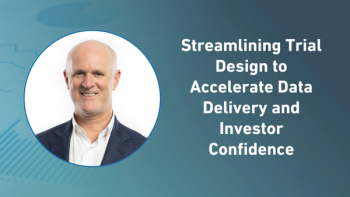
Navigating the Complexities of Patient Data in Clinical Trials
In this video interview with ACT editor Andy, Studna, Silvio Galea, chief data & analytics officer, WCG, highlights challenges with patient data from an operational perspective.
In a recent video interview with Applied Clinical Trials, Silvio Galea, chief data & analytics officer, WCG, discussed the challenges in the clinical trial industry, emphasizing low awareness among both patients and providers. He highlighted operational issues, including the difficulty in identifying and engaging patients, data interoperability, and ensuring data quality. Galea stressed the importance of user experience in electronic data capture tools and the need for industry standards. Prioritizing data collection should focus on safety, efficacy, and efficiency, ensuring data quality, and avoiding workflow disruptions.
A transcript of Galea’s conversation with ACT can be found below.
ACT: What are some challenges you are currently seeing in the industry around patient data?
Galea: If you look now at the at the operational viewpoint, there's a ton of data providers out there. Everybody wants to help you identify and get counts, and that's great, but, here's the issue with that. Number one, this is just an aggregate, and it's deidentified, and rightfully so. This is very private, sensitive data. It cannot be exposed willy-nilly. Even if we do the identification, how do we then go about getting in touch with the individual? How do we go about seeing if they're eligible for the trial? How do we go about having you that in-depth conversation with them, one that's meaningful, empathetic, and sensitive, versus it just being kind of like a cold call recruiting or an ad on Facebook. When you ask about what are some of the challenges in the industry, we've got a macro and a micro situation. We don't have a good path forward in the middle, just from identifying, reaching out, engaging, shaking hands, touching, and talking with potential participants. Then there's the issue over time. I spent some time at a payer and had the opportunity to do a lot of data interoperability. One of the things that I learned is that as a data provider, I only have a small segment of any individual's data; yourself, myself, our families, our friends see different doctors and different facilities and different states and different specialties across their life. I'm struggling to make sure that my kid’s healthcare data is all in one system, much less mine where—not to age myself—but, some of my records are on paper, on those little yellow pads, where it's like, did you have this immunization? Did you have that? Even if you have access to patient data, how do you know that you have access to all of it, and that you've got the right, holistic, longitudinal view of an individual. There's that challenge also, there's the macro, micro, and then longitudinal challenge. Then you're getting data from who knows how many different systems and how quality is the data? Who entered the data? How did they enter it? Was it a doctor who's focused on you as they're typing, or was it a doctor that was typing with their back towards you and the information that you were giving them was towards somebody's back? The quality is also not there. I could go on, but I think if I was to summarize—with patient data—it's making sure that I'm not looking at patient data from the perspective of clinical trial research space, number one, awareness; number two; quality, number three; being able to securely and within the private space, engage, reach out, and touch the patient in a in a way that's ethical, has sensitivity, has integrity, is safe, is secure, and is comforting.
Newsletter
Stay current in clinical research with Applied Clinical Trials, providing expert insights, regulatory updates, and practical strategies for successful clinical trial design and execution.






.png)



.png)



.png)
.png)
